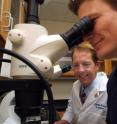Myostatin inhibitors may improve recovery of wartime limb injuries
Inhibiting a growth factor that keeps muscles from getting too big may optimize recovery of injured soldiers, researchers say. They are studying two myostatin inhibitors in mice with limb injuries, first to see which works best and then to identify the best delivery mechanism, says Dr. Mark Hamrick, bone biologist in the Medical College of Georgia Schools of Graduate Studies and Medicine.
"Fifty to 60 percent of the injuries occurring in Iraq are to the limbs, and the average injury requires five surgeries," Dr. Hamrick says. "Myostatin inhibitors are known to improve muscle regeneration and we have evidence that they also increase bone formation. We believe these inhibitors will result in a stronger, more rapid recovery for these soldiers and other victims of traumatic limb injuries."
A $1.2 million grant from the Office of Naval Research to Dr. Hamrick is enabling laboratory studies of two experimental myostatin inhibitors: a decoy receptor and a binding protein, both developed by MetaMorphix, Inc. of Beltsville, Md. Both inhibitors have been shown effective in muscle regeneration, but this is the first trial that looks at their impact on bone.
Two delivery mechanisms also will be studied. "Is the best approach a single injection bolus that circulates everywhere or just localized delivery?" Dr. Hamrick says.
Study collaborators include Dr. Li Liang of the life sciences company MetaMorphix, who will oversee development of the inhibitors; Dr. Xuejun Wen, bioengineer at Clemson University in Clemson, S.C.; and David Immel, radiographic imaging expert at Savannah River National Laboratory in Aiken, S.C., who will provide three-dimensional, high-resolution computerized tomography scans of injured limbs before and after treatment.
Myostatin is primarily produced by muscle cells. Females tend to produce more myostatin receptors, which helps explain why men tend to have greater muscle mass. Dr. Hamrick's lab also has found the receptor on bone-derived stem cells – needed to help repair an injury – and others have found it in healing fractures. "When you take it away, the healed callus that forms at the fracture site has more bone in it," says Dr. Hamrick. "Myostatin also increases fibrosis and scarring within tissue so part of what you are doing is blocking that."
Bone and muscle healing typically go hand in hand. Muscle provides blood, growth factors and potentially stem cells for a healing callus. It's not yet known how well bones reciprocate. "If you can improve muscle healing, you can improve bone healing," Dr. Hamrick says. "Young people have a tremendous potential to heal that can be improved with better approaches to preventing infection and to healing soft tissue and bone in an integrated manner."
Researchers hope to move to clinical trials in two to three years, Dr. Hamrick says. "If we find the primary role of myostatin is very early in the healing process and see a big jump in expression early in a fracture callus, it may be that a single injection bolus immediately after injury is the best time for treatment rather than continued treatment over a period of time."
Myostatin is most highly expressed during development, but adults have some as well, so blocking it still facilitates muscle growth and development, primarily in response to exercise. Myostatin expression also tends to rise following an injury, apparently to control proliferation of new and regenerating cells, Dr. Hamrick says. Although there is no FDA-approved myostatin inhibitor, body builders often take supplements that claim to reduce myostatin function and help build muscle.
A whole spectrum of naturally occurring genetic variations likely result in minor alterations in myostatin signaling that could help explain why some people are more muscular than others, Dr. Hamrick notes. In a separate study funded by the National Institutes of Health, he is using a genetically engineered 'mighty mouse,' which is missing the myostatin gene, to find the best way to optimize bone growth and help young people avoid osteoporosis. German researchers reported in 2004 in the New England Journal of Medicine the case of a child whose muscles already were bulging as a newborn apparently because of a dysfunctional myostatin gene.
Source: Medical College of Georgia
Other sources
- Myostatin inhibitors may improve recovery of wartime limb injuriesfrom PhysorgTue, 8 Jul 2008, 19:42:10 UTC
